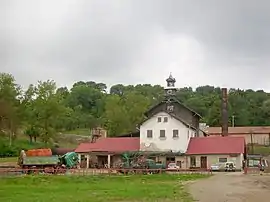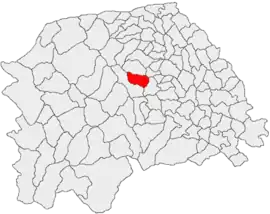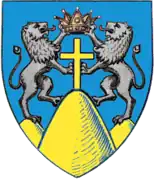Cacica
Cacica (Polish: Kaczyka, German: Kaczika) is a commune located in Suceava County, in the historical region of Bukovina, northeastern Romania. The commune is located in the central part of the county, 17 km (11 mi) from the town of Gura Humorului, 34 km (21 mi) from the city of Rădăuți, and 28 km (17 mi) from the county seat, Suceava. At the 2011 census, 74.8% of inhabitants were Romanians, 20.2% Poles, and 4.4% Ukrainians. Its Polish inhabitants are descended from settlers who arrived there at the turn of the 19th century during the Habsburg period.
Cacica
Kaczyka | |
|---|---|
 The salt mine in Cacica (September 2007) | |
 Coat of arms | |
 Location in Suceava County | |
 Cacica Location in Romania | |
| Coordinates: 47°38′N 25°54′E | |
| Country | Romania |
| County | Suceava |
| Government | |
| • Mayor (2020–2024) | Petru Tudosi[1] (PNL) |
| Area | 57 km2 (22 sq mi) |
| Elevation | 385 m (1,263 ft) |
| Population (2011-10-31)[2] | 3,712 |
| • Density | 65/km2 (170/sq mi) |
| Time zone | EET/EEST (UTC+2/+3) |
| Vehicle reg. | SV |
| Website | www |
Administration and local politics
Commune council
The commune's current local council has the following political composition, according to the results of the 2020 Romanian local elections:[3]
| Party | Seats | Current Council | |||||||
|---|---|---|---|---|---|---|---|---|---|
| National Liberal Party (PNL) | 7 | ||||||||
| Social Democratic Party (PSD) | 4 | ||||||||
| Union of Poles of Romania (UPR) | 2 | ||||||||
Villages
The commune is composed of five villages: namely Cacica, Maidan, Pârteștii de Sus (the commune center), Runcu, and Solonețu Nou.
Solonețu Nou
%252C_Solone%C8%9Bu_Nou_09.jpg.webp)
Solonețu Nou (Polish: Nowy Sołoniec, German: Neu-Solonetz or Lichtental) is one of the Polish villages in Suceava County, in the historical region of Bukovina, northeastern Romania. It was established in 1834 by 30 Polish families in the Soloneț river valley.
A Polish school was founded in the village in 1870. 523 people from the village were deported to Poland after 1945 and the school was closed. After the Romanian Revolution of 1989, the Polish school was reopened. In 1995 there were 718 inhabitants in the village. The Polish community from Solonețu Nou (together with those of Solca, Pleșa, Racova, and Arbore) has 365 families with 1046 Roman Catholics of Polish ethnicity.
Natives
- Valeriu Alaci (1884–1955), Romanian mathematician
- Ghervazen Longher (born 1972), Polish-Romanian politician
- Serghei Nicolau (1905–1999), Russian-Romanian communist espionage chief and a Securitate general
Gallery
 Roman Catholic chapel dedicated to Saint Barbara, located in the salt mine
Roman Catholic chapel dedicated to Saint Barbara, located in the salt mine Roman Catholic Polish basilica in Cacica
Roman Catholic Polish basilica in Cacica Roman Catholic church in Solonețu Nou
Roman Catholic church in Solonețu Nou Greek Catholic church in Cacica
Greek Catholic church in Cacica Orthodox church in Cacica
Orthodox church in Cacica Cacica kindergarten
Cacica kindergarten Cacica elementary school
Cacica elementary school Panoramic view over Cacica, with the Orthodox church in the background
Panoramic view over Cacica, with the Orthodox church in the background.jpg.webp) Panoramic view over Cacica, with the Roman Catholic basilica seen in the background
Panoramic view over Cacica, with the Roman Catholic basilica seen in the background Solonețu Nou (Polish: Nowy Sołoniec) village, with the local Roman Catholic church seen in the background
Solonețu Nou (Polish: Nowy Sołoniec) village, with the local Roman Catholic church seen in the background%252C_Solone%C8%9Bu_Nou_03.jpg.webp) Rural landscape from Solonețu Nou (2018)
Rural landscape from Solonețu Nou (2018)%252C_Solone%C8%9Bu_Nou_06.jpg.webp) Solonețu Nou (2018)
Solonețu Nou (2018)
See also
References
- "Results of the 2020 local elections". Central Electoral Bureau. Retrieved 9 June 2021.
- "Populaţia stabilă pe judeţe, municipii, oraşe şi localităti componenete la RPL_2011" (XLS). National Institute of Statistics.
- "Rezultatele finale ale alegerilor locale din 2020" (Json) (in Romanian). Autoritatea Electorală Permanentă. Retrieved 2020-11-02.
- (in Romanian) Pr. Mihai Patrașcu, Vizită pastorală la Soloneţu Nou ("A pastoral visit to Solonețu Nou"), on the site of the Roman Catholic Episcopate of Iași. Undated, but index places it as December 2005. Accessed 7 Jan 2006.
